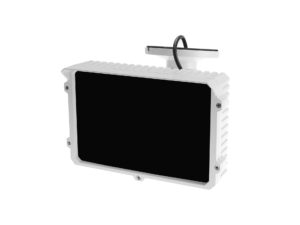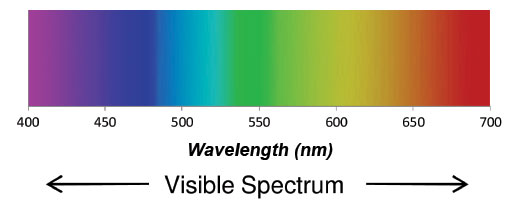There are two common IR wavelengths used in CCTV applications today. IR or Infrared wavelengths are measured in ‘nm’ or nanometers, which are used to specify the wavelength of electromagnetic radiation near the visible part of the light spectrum. Visible light ranges from about 390 to 700nm. The IR in CCTV applications take over from there, commonly 850nm and 940nm, which allow us to see images that would normally fall outside of our visible range, thus IR Illuminator. These CCTV IR LED’s are used to produce, or improve ‘Night Vision’ capabilities for security cameras.
Although the IR wavelengths 850nm and 940nm, respectively, are fairly similar in performance, there are a few important differences worth noting. The use of IR LED’s in security cameras has become commonplace as technology has improved dramatically and cost has come down. Generally, the great majority of security cameras or CCTV Cameras are sensitive to the 850nm wavelength. Although the IR light is invisible to the human eye, the CCTV IR LED’s will produce a faint red glow when looking directly at the camera or source.
The main advantage of the 940nm wavelength is that the IR LED’s do not produce any visible glow. In other words, they are completely invisible and can be used in applications that are required to be more covert. In fact, many people refer to them as ‘Covert IR’. This type of IR is also useful in places where a red glow may be mistaken as a signal and can not be used. The disadvantage of 940nm is that they are about 30-40% less effective and will illuminate less distance.
When using a separate, or stand-alone IR Illuminator such as the LUMI-240 IR Illuminator , it is important to make sure your CCTV camera is sensitive to the same wavelength as emitted by the illuminator. In other words, if the illuminator is 850nm, your security camera must be sensitive to that wavelength. Most cameras are sensitive to 850nm. Security Cameras that are 940nm IR are available as well, but much less common.
Most Security Cameras with built in IR LED’s, use an IR Cut Filter in order to maximize different lighting conditions during the day or night. During the daytime, the filter is on in order filter out Infrared Light, that way, color images are not distorted by IR Light. During the nighttime, the IR cut filter is automatically switched off to allow infrared light to enter the camera. The camera switches to IR Mode (Black and White) which is more sensitive to Infrared light.
IR technology has made great strides in recent years which is a great benefit to consumers and commercial CCTV users. SMART IR, Black Film Technology and STARVIS Sensors are among the exciting new Night Vision improvements in the surveillance industry. It is now possible to see extreme distances during day and night with high powered IR LED’s and IR Illuminators. If you are planning a CCTV Installation that requires night vision, it is certainly beneficial to understand the options that are available to you. At Ellipse Security, we are always ready to assist with your planning and design needs.
Have questions?
Call us Toll-Free at 877-880-7728
We Love to Talk to People about Security Cameras!


Hey I know this is off topic but I was wondering if you knew of any widgets
I could add to my blog that automatically tweet my newest twitter updates.
I’ve been looking for a plug-in like this for quite some time and was hoping maybe
you would have some experience with something like this. Please let me know if you
run into anything. I truly enjoy reading your blog and I look forward to your new updates.
Thanks for the great post
Nice post. I learn one thing more challenging on totally different blogs everyday. It will at all times be stimulating to read content from different writers and practice a bit something from their store. I? desire to make use of some with the content on my blog whether or not you don? mind. Natually I?l give you a link on your net blog. Thanks for sharing.
Aw, this was a very nice post. In thought I wish to put in writing like this moreover ?taking time and actual effort to make an excellent article?but what can I say?I procrastinate alot and certainly not seem to get one thing done.
Thanks for the wonderful guide
Thanks for the wonderful guide
This is actually useful, thanks.
“Although the IR light is invisible to the human eye, the IR LED’s will produce a faint red glow when looking directly at the camera or source.”
To add to that, 850nm and 940nm are equally invisible to the human eye, however LEDs put out a bell-curve of wavelengths (nothing’s perfect!) that can span more than 100nm. For a nominally 850nm consumer-grade LED, there is enough residual power in the visible red spectrum to see the glow. From 940nm the bell curve’s tails are too far gone by the time you get down into the 700s of nm, though with an extremely bright 940nm LED or one with a very broad spectrum, it might be visible. Most other light sources (incandescent filament bulbs, fluorescent, solar fusion) have messy spectra with numerous peaks all across the range, which is why things can look weird under the unnaturally precise (nearly-)single-color of LEDs unless multiple are combined to simulate natural light. (Hence “white” LEDs, though there is no such thing as a single white wavelength of light!) More precise LEDs can be had for specialty needs, but LASER is a whole nother level and can be spread over less than 1nm from its nominal color! And likely far more precise than that for crazy applications like particle physics.
Way cool! Some extremely valid points! I appreciate you writing this article and also the rest
of the site is very good.
do most android smart phones see 940nm light?
Yes, but very weak. They have a red filter for the lens. If you remove that filter the LED will be much brighter!